| Reviews & Columns |
|
Reviews DVD TV on DVD Blu-ray 4K UHD International DVDs In Theaters Reviews by Studio Video Games Features Collector Series DVDs Easter Egg Database Interviews DVD Talk Radio Feature Articles Columns Anime Talk DVD Savant Horror DVDs The M.O.D. Squad Art House HD Talk Silent DVD
|
DVD Talk Forum |
|
|
| Resources |
|
DVD Price Search Customer Service #'s RCE Info Links |
|
Columns
|
|
|
Jean-Luc Godard + Jean-Pierre Gorin: Five Films, 1968-1971
The Movies:
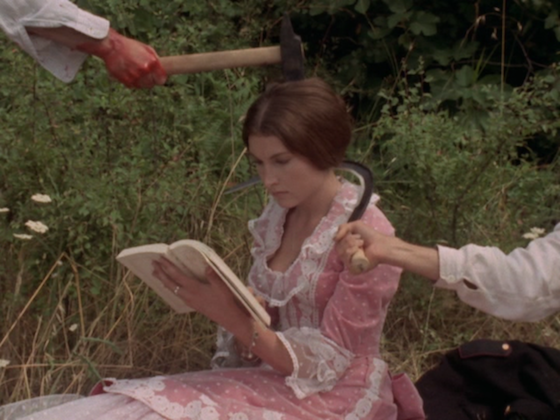
Arrow Video's Academy label brings the curious film fan a piece of the Jean-Luc Godard puzzle that has been long overdue on American home video. Godard + Gorin: Five Films, 1968-1971 represents Godard's most politically radical period, when he and collaborator Jean-Pierre Gorin led a filmmaking collective called the Dziga Vertov Group (named after the Soviet director of The Man with the Movie Camera). The group's final two completed films, Tout va bien and Letter to Jane, saw release by the Criterion Collection years ago, but those works had the benefit of stars Jane Fonda and Yves Montand to attract attention. The other Dziga Vertov films, meanwhile, have the reputation of being abrasively uncommercial agitprop screeds.
The reputation is somewhat earned. After the cataclysmic shift in French culture after the strikes and riots of May '68, Godard felt the need to attack film language and what he deemed bourgeois film convention with the same revolutionary fervor. Following the philosophy of Mao Zedong, he (and, in the latter three films in this set, Gorin) found it important that radical theory must be joined with radical practice. The only hitch is, if you're not already familiar with Communist theory, be it of the Marxist, Leninist, or Maoist variety (which I'm not, bee tee dubs), there are plenty of concepts and bits of terminology thrown at you that will inspire either a flurry of Google searches or a gradual glassing-over of the eyes. If you're anti-Communist, these flicks are just flat-out not for you; one presumes the original intended audience was radicalized students and workers who might appreciate a challenging break from mainstream media pablum. Now, the films are mostly interesting for historical value, although certain sequences (especially those that engage with racial and gender inequalities) resonate powerfully in this political moment.
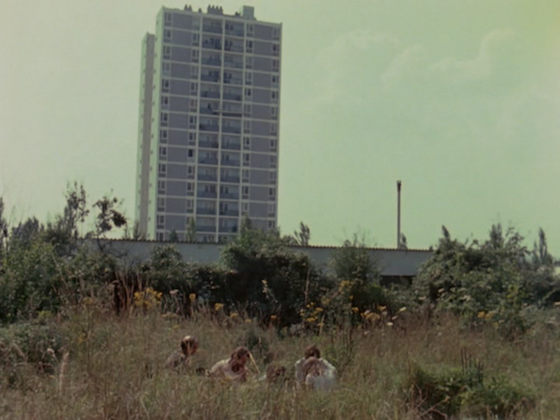
One of Godard's consistently endearing traits, no matter how esoteric or obscure his films may become, is his mischievous sense of humor (or is it, humorous sense of mischief?). This is apparent in the title of the first film in the set, Un film comme les autres (A Film Like the Others). Un film is a dialectical collage that little resembles a standard popular picture. Made shortly after the events of May, this film has a rawness that could be interpreted as Godard just starting to process the scope of what has happened.
The film consists essentially of two threads: one is black-and-white newsreel footage of May '68 protests and the other is a newly shot discussion between leftist workers and students in a grassy patch behind the Renault factory. The film does not identify the people speaking -- they are frequently shot with their faces purposefully out-of-frame or obscured by the tall grass -- nor does it identify the setting. Only in the supplemental interview with Godard historian Michael Witt, included on another disc in this set (see "Special Features" below), do we learn that the field outside the Renault factory is the spot where a teenager was killed, while protesting for the welfare of the factory workers. This missing context, which might have seemed obvious to a French viewer at the time, provides a key as to why the film focuses so much upon the failures of May '68, as well as the unrealized potential this brief period revealed.
I've been reading some different reviews of this box set online, and it's interesting to see where reviewers' tastes diverge. For me (but clearly not everybody), Un film comme les autres was probably the overall toughest sit, partly because it is the longest film in the set (roughly 110 minutes) and partly because it is earnestly dry. Many of the approaches and devices that Godard utilizes -- especially the use of a densely packed soundtrack that diverges from the visuals more often than it supports them -- are revisited in later films, to typically better effect. Here, it's overwhelming and ultimately tiring.

The second film in the set is a 52-minute English-language essay called British Sounds (aka See You At Mao). It's a free-associative exploration of the plight of the English worker, which again incorporates a number of collaged and overlapping soundtracks (hence the title) over a series of striking visual sequences. This particular flood of disjointed snippets of revolutionary theory, history, and documentary is relatively less overwhelming than the previous flood, if only because Godard indulges his eye (and his irony) more here. It's a far more energetic and edifying film.
While the last film had us outside a car factory, this film goes inside, beginning with a ten-minute tracking shot that pulls us steadily along the assembly line. Godard is interested in the workers, but British Sounds is less single-minded than Un film comme les autres. The lack of equality for women is addressed in sequences where feminist critique is spoken over images of a nude woman walking through a suburban-looking home. Footage of a far-right commentator that descends from elitist, racist ranting to inhuman, murderous plotting would be darkly funny if it wasn't so galling. Godard typically supports radical youth, but one can't help but assume that ironic amusement is the reason for including a sequence that features a group of gathered students who try to re-write Beatles lyrics to make them more politically engaged (or, in the case of "Revolution," more in line with their own political convictions).
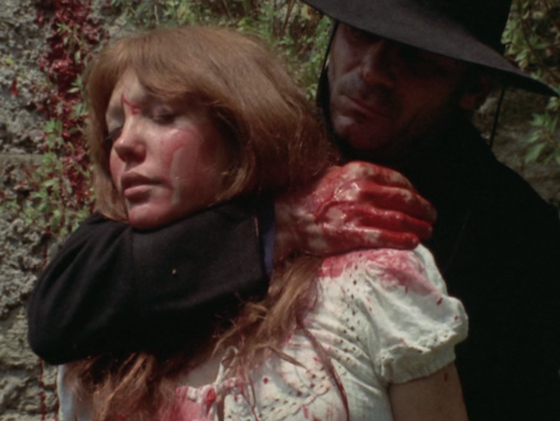
Like many of his French New Wave brethren, Godard is fascinated by Hollywood filmmaking and especially genre filmmaking. Le vent d'est (The Wind from the East) sees that fascination creeping into the Dziga Vertov Group's work. Godard and Gorin deconstruct the western in Le vent d'est, as they more pointedly integrate aesthetic and film theory into their (by now familiar) bombardment of theoretical citations. A band of actors (including Godard's then-wife Anne Wiazemsky) hole up in the Italian woods and enact scenes that faintly resemble a spaghetti western. However, their discussions relate to modern-day politics and mostly filmmaking itself, with the influence of capitalism upon Hollywood and the insidious creep of revisionist thinking in revolutionary filmmaking being the main targets. (Considering his long-time, worldwide canonization, it's odd -- but also oddly refreshing -- to hear Sergei Eisenstein be criticized for romanticizing the past, rather than using his camera to report upon what was going on around him.)
Maybe it's my own bias as a film addict, but I found Le vent d'est to be the most engaging work in this set. Setting aside all the critical film discussion, there's a lot more play in the Vertov Group's approach to the material. Wiazemsky, not as her "character," often laughs or is on the verge of laughing. Images of another actress being made up for the camera is counter-pointed with shots of an actor layering gloppy colorful paint on his face, resembling a kindergartner's idea of native warpaint.
Clearly, there were moments where the production fell apart because the collective cast and crew could not agree on the ideas being expressed; rather than ignore this, the film removes what tenuous aspects of the fourth wall exist here and shows us the behind-the-scenes arguments, which are often so vigorous that little of it is intelligible on the soundtrack.
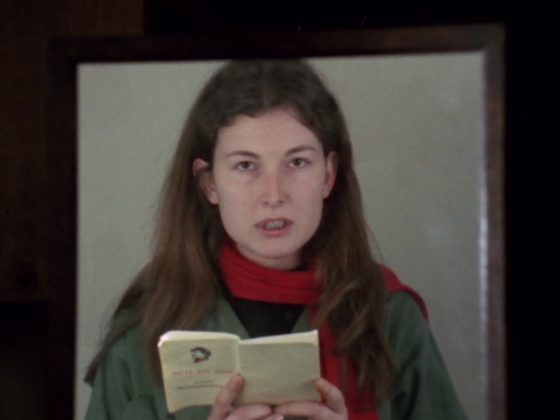
Lotte in Italia (Struggles in Italy) is kind of like a cracked educational film or after-school special. It has a main character, Cristiana Tullio-Altan as Paola Taviani (an in-joke on director Paolo Taviani, we must presume), and a vague narrative, but these elements just serve to illustrate the workings of ideology in daily life and how the burgeoning revolutionary must stay vigilant not to succumb to bourgeois values.
Paola has sex with her boyfriend in the afternoon, but then realizes that this is a class privilege; after all, factory workers can only do it at night when it's not as good. Paola gets a job at a clothes factory to be closer to the workers, but her eagerness to radicalize them just isolates her.
Lotte in Italia is constructed through the use of auto-critique, as the second section of the film critiques the first section, and then the third section critiques everything that has come before. It's a stimulating process, but not one that unfolds with any real drama. It doesn't help the film's momentum that subtitle-averse Godard has French voices dub over the original cut's Italian voices -- but with a delay, like in a TV broadcast. Ironically, the version we're watching does have subtitles, and the choice has been made to have only the French voices subtitled. This adds an element of waiting, where we must sweat out the Italian dialogue until the French translation, and the English translation of the French translation, resumes. This flick'll make you work for your comprehension, in other words.
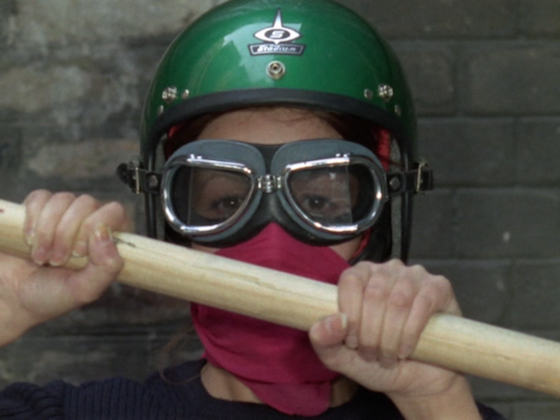
The final film in this set is the oddest as well. Vladimir et Rosa is an off-kilter fictionalization of the infamous Chicago Eight trial (more recently reconstructed for the documentary, Chicago 10). Godard and Gorin cast themselves in the film as implicated filmmakers Frederick Vladimir and Karl Rosa (the last names, as used in the title, are meant to evoke a famous dialogue between Vladimir Lenin and Rosa Luxembourg, while the characters' first names refer to the authors of the Communist Manifesto). Vladimir and Rosa are portrayed as a would-be comedy team -- discussing their filmmaking hurdles on a tennis court while bougie couples try to play doubles tennis over their heads.
The attempts at comedy are welcome, but rarely work. (I did laugh out loud a few times; a scatological joke about what defines a racist probably being the biggest gutbuster.) One major failed comic choice is the film's broad, caricatured version of Judge Hoffman, who presided over the Chicago Eight trial, and who is portrayed here as a porn-obsessed buffoon called "Judge Himmler" (because fascism, get it?).
Instead, the film works better when it tackles the horrifying and racist treatment of Bobby Seale, which included being chained to his chair and gagged during the trial. Even within the low-budget Brechtian space that Godard and Gorin utilize to evoke a courtroom (essentially a bunch of disconnected close-ups, framed against various walls in Godard's apartment), the film's reenactment is visceral.
Anne Wiazemsky and La Chinoise's Juliet Berto are cast as two other members of the Chicago Eight (who were all men in real life). This gives the filmmakers another chance to delve into feminist critique, as typified by an excellent scene where Wiazemsky tries to show her boyfriend that he is misreading a text by a radical South African woman but he doesn't quite believe her. It's a sideways glimpse of the mansplaining phenomenon forty-some years before the term was coined.
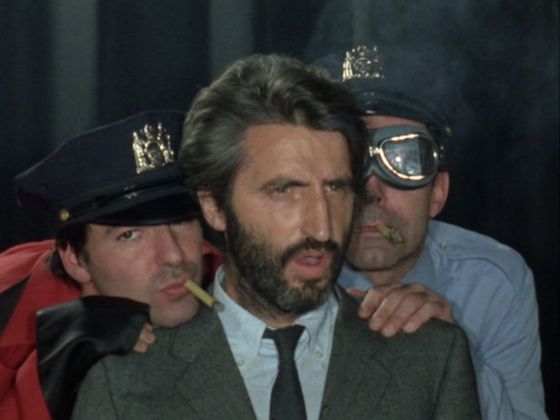
The Blu-ray
Godard + Gorin: Five Films, 1968-1971 is a dual-format collection, consisting of 3 Blu-rays and 3 DVDs. It is packaged with a 60-page color booklet that includes an essay by Michael Witt and some vintage interviews and manifestoes by Godard and Gorin.
The Video:
All five films were shot guerrilla-style in 16mm, so the AVC-encoded 1080p 1.33:1 transfers are innately limited. Even without being technical jawdroppers, there's a pleasing amount of depth in the transfers, strong detail reproduction (considering the source), and appropriately saturated and balanced colors.
The Audio:
The audio for each film is typically even less polished than the imagery. Godard and Gorin have designed and layered these soundtracks with an intellectual complexity that is admirable. But, in the audiophile sense, they're not exactly elegant. Still, the LPCM mono audio rarely sounds overburdened or overblown. All films, including the English-language British Sounds, come with optional English subtitles.
Special Features:
(HD, 2:08:20) - A free-floating chat from 2010, in which a cigar-puffing Godard responds to questions about his entire career. He's unsurprisingly thoughtful in sometimes opaque ways, and he's not above being a grouchy contrarian. Going over some of his older work, he dismisses Band of Outsiders as his worst film and condescends to those (like the interviewer) who would consider it a great cult film. In contrast, he's much happier to talk about Weekend, the film which essentially signaled the end of his original, more commercial style of filmmaking. If you're interested in Godard's work enough to buy this box, then this interview should prove interesting to you.
Final Thoughts:
At last, Jean-Luc Godard's most radical films, made in collaboration with Jean-Pierre Gorin, have received a legitimate stateside release on home video. This release will appeal to those of us who find Godard fascinating, even when he is frustrating. First-timers are recommended to stick with Godard 101 (Breathless, Contempt, Alphaville) before moving on to advanced studies. But, if you've done your homework (studying some Mao wouldn't hurt either), there's a lot of intriguing stuff to pick apart here. Highly Recommended.
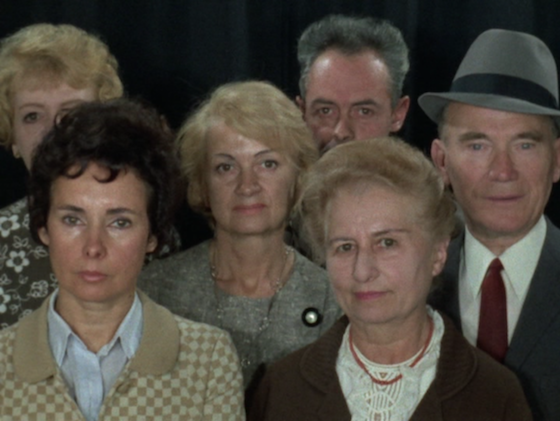
Justin Remer is a frequent wearer of beards. His new album of experimental ambient music, Joyce, is available on Bandcamp, Spotify, Apple, and wherever else fine music is enjoyed. He directed a folk-rock documentary called Making Lovers & Dollars, which is now streaming. He also can found be found online reading short stories and rambling about pop music.
|
| Popular Reviews |
| Sponsored Links |
|
|
| Sponsored Links |
|
|
| Release List | Reviews | Shop | Newsletter | Forum | DVD Giveaways | Blu-Ray | Advertise |
|
Copyright 2024 DVDTalk.com All Rights Reserved. Legal Info, Privacy Policy, Terms of Use,
Manage Preferences,
Your Privacy Choices | |||||||













